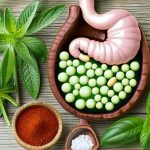Nausea and digestive discomfort are incredibly common experiences, ranging from mild queasiness after an indulgent meal to more persistent upset triggered by travel, stress, or even just hormonal shifts. Thankfully, for many instances of mild nausea and general digestive unease, there’s a wealth of gentle, time-tested remedies available right in our kitchens or easily sourced from nature. These aren’t meant to replace professional medical attention when symptoms are severe or persistent—always consult a healthcare provider if you have concerns – but rather offer accessible ways to soothe discomfort and support your body’s natural healing processes during those less intense moments. Understanding the root cause of your nausea is also crucial; is it related to food, motion sickness, anxiety, or something else? This will help tailor your approach to relief.
The beauty of these natural remedies lies in their often gentle nature, focusing on calming the digestive system and reducing inflammation rather than masking symptoms. Many cultures have long traditions surrounding herbal medicine and dietary practices for easing digestion; from ancient Ayurvedic principles to traditional Chinese medicine, there’s a rich history of using plants and specific foods to restore balance within the gut. We will explore some of these time-honored approaches, focusing on herbs, teas, and simple lifestyle adjustments that can make a significant difference when you’re feeling unwell. The goal isn’t necessarily to eliminate nausea instantly, but rather to lessen its intensity and promote overall digestive wellbeing. If recurring nausea or headaches are a problem, consider checkups that explain the source.
Herbal Allies for Digestive Calm
Herbs have been used for centuries to address various health concerns, and many possess properties that can effectively soothe the digestive system and alleviate mild nausea. Ginger is arguably the most well-known remedy; it contains compounds called gingerols which are believed to help speed up gastric emptying – essentially moving food through your digestive tract more quickly, reducing feelings of fullness and bloating. Peppermint, on the other hand, works by relaxing the muscles in the stomach and intestines, which can reduce spasms and ease discomfort. Chamomile, frequently enjoyed as a tea, has calming properties that extend to the digestive system, helping to reduce stress-related nausea and promote relaxation – an important factor since anxiety often exacerbates digestive issues.
Beyond these popular choices, other herbs deserve consideration. Fennel seeds, traditionally chewed after meals, can help with bloating and gas, reducing discomfort associated with digestion. Cardamom is another spice that aids in digestion; its aromatic compounds are thought to stimulate digestive enzymes and reduce flatulence. Licorice root has a long history of use for soothing the stomach lining and alleviating nausea, though it’s important to note that licorice can interact with certain medications and isn’t suitable for everyone – particularly those with high blood pressure. Remember that herbal remedies aren’t one-size-fits-all; it’s best to start slowly and observe how your body responds. It’s also good practice to understand tests that connect gut health with neurological symptoms.
The key to utilizing herbs effectively is understanding their preparation methods. Ginger, for example, can be consumed fresh (grated into tea or food), in powdered form, as a crystallized ginger snack, or even as ginger ale (though choose natural versions with minimal added sugar). Peppermint is best enjoyed as a tea, allowing the volatile oils to release their calming properties. Chamomile should also be prepared as a tea, using high-quality dried flowers for optimal flavor and benefits. It’s crucial to source herbs from reputable suppliers to ensure purity and quality.
Soothing Teas for Digestive Relief
Teas are an incredibly accessible way to incorporate herbal remedies into your daily routine. They’re hydrating, often comforting in themselves, and provide a gentle delivery method for the beneficial compounds within the herbs. Peppermint tea is a classic choice for nausea relief; its menthol content can help relax stomach muscles and reduce feelings of queasiness. Brewing peppermint tea involves steeping 1-2 teaspoons of dried peppermint leaves in hot water for about 5-10 minutes. Sipping it slowly allows the vapors to further soothe your digestive system.
Chamomile tea, as mentioned earlier, is fantastic for calming both the mind and gut. Its gentle floral flavor makes it a pleasant option, especially before bed, offering a dual benefit of relaxation and improved digestion. To brew chamomile tea, use approximately 1-2 teaspoons of dried chamomile flowers per cup of hot water, steeping for 5-7 minutes. Adding a touch of honey can enhance the flavor but isn’t necessary. Remember to choose organic chamomile whenever possible to avoid pesticides and ensure quality.
Ginger tea is another powerful option, particularly effective for motion sickness or nausea related to food sensitivities. You can make ginger tea using fresh ginger slices (about 1 inch peeled and grated) simmered in hot water for 10-20 minutes. Strain the tea before drinking, and consider adding a slice of lemon or a drizzle of honey for flavor. A word of caution: those with gallbladder issues should consult their doctor before consuming large amounts of ginger; scans and labs can help detect any underlying issues.
Dietary Adjustments to Minimize Discomfort
Beyond herbs and teas, making mindful dietary adjustments can significantly reduce nausea and digestive upset. The BRAT diet – bananas, rice, applesauce, and toast – is a well-known recommendation for mild cases of diarrhea or nausea because these foods are bland, easy to digest, and help bind the stool. However, it’s important not to rely on the BRAT diet long-term, as it lacks essential nutrients. It’s best used as a temporary measure while your digestive system recovers.
Staying hydrated is paramount when experiencing nausea; dehydration can worsen symptoms. Sip small amounts of clear fluids throughout the day – water, herbal teas (like chamomile or ginger), and electrolyte solutions are excellent choices. Avoid sugary drinks, carbonated beverages, and caffeine, which can irritate the stomach. Eating smaller, more frequent meals instead of large ones puts less stress on your digestive system. If you suspect low appetite or early satiety is a factor, digestive tests can provide clarity.
- Focus on bland foods: toast, crackers, plain yogurt, boiled potatoes.
- Avoid fatty, greasy, or spicy foods: these are harder to digest and can trigger nausea.
- Limit dairy products: some people find dairy difficult to digest when experiencing nausea.
- Chew food thoroughly: this aids digestion and reduces the burden on your stomach.
It’s also important to identify any potential food sensitivities or triggers that might be contributing to your digestive discomfort. Keeping a food diary can help you pinpoint which foods exacerbate your symptoms, allowing you to make informed dietary choices. For example, if you consistently experience nausea after consuming gluten, it may be worth exploring whether you have a sensitivity to wheat or other gluten-containing grains. Consider lab and scan results if concerns persist.
It’s vital to reiterate that these remedies are intended for mild nausea and digestive discomfort. If your symptoms are severe, persistent, accompanied by fever, vomiting, diarrhea, or abdominal pain, seek medical attention immediately. This information is not a substitute for professional medical advice, diagnosis, or treatment. Always consult with a qualified healthcare provider before making any changes to your diet or lifestyle, especially if you have underlying health conditions or are taking medications. For travel-related issues, review digestive habits for a smoother journey. And remember that supportive remedies like soups and stews can aid in healing.


















